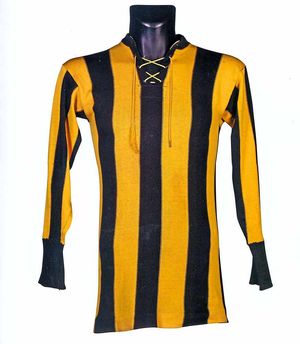WATCH: Historic Wolves shirts brought to life in unique new book
Few football shirts are as iconic as the old gold and black of Wolverhampton Wanderers.
First donned in 1889, the colours have graced the backs of Wolves greats through the good times and bad.
Now the history of the shirt has been put in print by die-hard fan Steve Plant who was launching They Wore The Shirt at a special event at Molineux.
The 255-page coffee-table book is the product of his vast personal collection and his commitment to documenting the history of the club through the shirt.
Only 1,877 copies have been produced – a nod to the year Wolves were formed – with each containing glossy pictures of 113 shirts.
Author Plant, aged 55, said: "There are many shirts in there that people will never have seen before and perhaps didn't even know existed.
"A book about shirts sounds boring but when people open it they never expect it to look like it does. It is the entire history of Wolves done from a different angle."

They Wore The Shirt begins by chronicling the club's inception and the team founded in 1877 by a group of pupils at Blakenhall's St Luke's school.
Back then the shirts worn by players were hardly recognisable from those produced today.
Plant writes that knitted or worsted jerseys and later gentlemen's flannel dress shirts typically formed a player's attire.
Most notably the shirt worn by the early St Luke's side featured blue and white hoops.
By 1883 the club had switched to red and white vertical stripes with the reason for the change remaining a mystery to this day.
In 1889 gold and black was adopted for the first time to match the colours of Wolverhampton's new coat of arms created a year earlier.
The motto on the coat of arms read Out Of Darkness, Cometh Light – with black used to symbolise the dark and gold representing the light.
After a brief return to red and white stripes in 1890, a new Football League order requiring teams to register official colours forced Wolves back into gold and black to avoid a clash with Sunderland.
Whereas the design of the shirt has changed many times since, the iconic colours have been an ever present.
The earliest shirt pictured in the book is the 1907-08 home shirt. It is believed to be the oldest Wolves jersey in existence.
It came to Plant via a dusty attic in Canada following an Express & Star appeal for old shirts to help create the book.
He said: "A man from Canada who does house clearances, and has got a bric-a-brac shop and sells this on, found this ancient gold and black shirt while he doing a house clearance.
"At first he thought it was an old ice hockey shirt. But then he spent quite a bit of time researching it and found that it closely resembled Wolves' 1921 FA Cup final shirt.
"He put something out on Facebook and a couple of people who knew about my book spotted it, and put him in touch with me."

There is a suggestion that it may have belonged to John Brodie, who played a key part in the formation of Wolverhampton Wanderers, with his family believed to have emigrated to Canada.
Other notable entries include the shirts worn by Wolves greats in the hugely successful 1950s.
Among them are the floodlight friendly fluorescent gold shirts made famous by a series of challenge matches against top Continental club sides which served as the precursor to European football competitions.
Pictured in the book is the very shirt worn by Honved Hero Roy Swinbourne who provided the catalyst for the famous victory over the Hungarian side in 1954.
Also featured are shirts from Wolves FA Cup victories and an England shirt worn by Billy Wright against Germany.
A selection of popular Umbro shirts follow from between 1970 and 1986 including the 1977-79 home jersey which was voted the club's most popular of all time in a vote conducted by Plant on Twitter.
The book then enters 'The Bully Years' during which the shirt was distinguished by iconic sponsors including Staw Distribution, Mander Paint & Ink and Goodyear.
Its final section charts the Millennium Years including the 2002-03 play-off final shirt worn by goalscorer Nathan Blake.
Creating the book has been a labour of love for Plant who started collecting Wolves shirts to show his father John after the latter was diagnosed with pancreatic cancer and given just months to live by doctors.
He said: "I would take each shirt round to show him as I got it and you could see it would put a sparkle in his eye.
"He said are you going to start collecting them and I said yes.
"That was when I started buying anything and everything Wolves related."
Before his death and while in hospital, Plant's dad refused operations and treatment claiming he had enjoyed a great life and wanted any available resources to help those who had not yet had one.
As a result of those views all profits from the sale of the book will be handed to Birmingham Children's Cancer Unit.
Copies of They Wore The Shirt can be purchased online via the Wolves shop or at the club's shops at Molineux and in the city centre.




